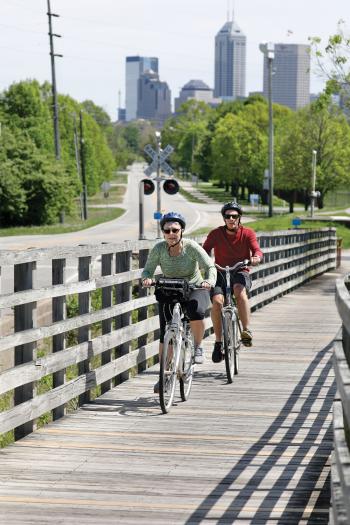Hot On The Trails: A Road-Free Guide To Exploring Indy

As the crow flies, Central Indiana is pretty close to the origin of America’s urban and suburban greenway trend. But we followed a winding path before arriving at the trail-building boom Indianapolis and the surrounding counties have enjoyed in recent years.
In 1963, May Theilgaard Watts, a schoolteacher in the Chicago suburbs, got things moving with a letter to the editor. Her plea to take a local railroad that was being torn up and convert it into a trail for everyone to enjoy eventually spurred construction of the Illinois Prairie Path, still thriving today.
A “rails to trails” movement was born, and it crossed the country. “In the ’70s and ’80s, it was about making land usable for people in the community and not wasting it,” says Eric Oberg, Midwest regional director of trail development for the national Rails-to-Trails Conservancy.
“First, it was just a few cities, and then the states caught on to this movement,” says Oberg. “The federal government didn’t do anything major until the 1990s, and that acknowledgment accelerated trail development all over the country.” In 1992, Congress passed a law to fund rail-trails, and the conservancy helped open its 600th greenway two years later: Indy’s own Monon Trail. Quickly crowded by users and lined by businesses, cultural destinations, and recreational attractions from Marion to Hamilton counties, the pedestrian- and bicycle-friendly corridor has justified the investment and spurred construction of new greenways, rail-trail and otherwise, across the region. The Monon and another standout, the Indianapolis Cultural Trail (the two now connect near Mass Ave and 10th Street), are consistently cited as groundbreaking by Oberg’s group and other experts, including former Indy resident Aaron Renn, a senior fellow at the Manhattan Institute for Policy Research. According to Renn, trail-building is no longer just about the opportunistic conversion of railroads; it adds serious value to a community. “Trails have shifted from a want to a need in the last 15 years,” he says. “Now, a great trail is an amenity and a new form of infrastructure your city and community have to have.”
“The Monon’s presence increased property values, so it really paid for itself with the tax revenue,” Renn continues. In the future, he says, cities and towns will build around trails, since it’s been proven they can be economically successful. Indeed, the Monon was a focal amenity for much of Carmel’s new city-center development, connecting its Arts & Design District, Center for the Performing Arts, and other destinations.
Neighboring communities have taken note, and trails are winding their way through the doughnut counties, particularly in Hamilton, where a proposed extension of the Nickel Plate Trail might someday connect Fishers to cities as far north as Rochester, nearly 100 miles away. Increasingly, communities incorporate trails into their long-term infrastructure and development planning. “Not many other states think about trails from that perspective or have the fortitude to tackle it,” Oberg says. “But Indiana definitely has created—and will in the future—strong trails, especially in urban areas.”
Multi-use Indiana trails cover 577 miles, with 27 rail-trail projects underway. We’re playing catch-up: Illinois and Ohio each double our length, and Michigan puts us to shame with almost 2,400 miles. But “dwelling on numbers isn’t the best thing,” says Oberg. “Indiana is the best example of trail-making in the country. You have shining stars.”
THE MONON TRAIL, UPDATED
In many ways, the granddaddy of Central Indiana’s greenways feels like its most youthful. Here’s why.
INDY’S CENTRAL CANAL TOWPATH
Call it the non-Monon: This route connects some of the city’s top cultural attractions and destination neighborhoods, but has a unique rural character all its own.
INDY’S WHITE RIVER WAPAHANI TRAIL
Runners looking for distance without crowds hop onto the Wapahani, where recreational and cultural destinations abound along the way.
INDIANAPOLIS CULTURAL TRAIL
Indy’s downtown greenway gives users access to more great stuff than we can list here. But IM’s own self-guided tour hits some gems.
INDY’S PLEASANT RUN TRAIL
A homey bike shop with espresso and European sammies is one of several good reasons to squeeze the brakes when riding this greenway on Indy’s near-south side.
INDY’S FALL CREEK TRAIL
Following its namesake waterway, this route offers a pleasant alternative to northeastside commuters who work downtown.
INDY’S TOWN RUN TRAIL PARK
Maintained by the Hoosier Mountain Bike Association, the nearly 7 miles of packed-dirt paths are a haven for off-road cyclists.
PENNSY TRAIL
Finished sections in Irvington, Cumberland, and Greenfield, are previews of a route that will one day connect Indy and its eastern suburbs.
PLAINFIELD’S WHITE LICK CREEK TRAIL
At the center of Plainfield’s versatile, interconnected greenway system, White Lick Creek Trail can accommodate runners seeking variety in length and routes.
ZIONSVILLE’S BIG-4 RAIL TRAIL
Formerly known as the Zionsville Rail Trail, this greenway through the heart of the northwestern suburb is a favorite of children and parents, at the center of a sprawling system that spans Boone County.
FRANKLIN GREENWAY TRAIL
This system connects the charming Johnson County seat’s downtown with Franklin College, woods, wetlands, and parks—as well as restaurants, shops, and historic and cultural destinations.
NOBLESVILLE’S WHITE RIVER GREENWAY
The scenic Hamilton County route begins on the edge of downtown Noblesville and travels through 150-acre Forest Park, across State Road 19, and north along the wooded banks of the White River.
GREENWOOD’S TRACY TRAIL
In the suburban heart of Greenwood, the route provides a pedestrian- and bike-friendly corridor connecting Summerfield, Woodmen, and Craig parks.





